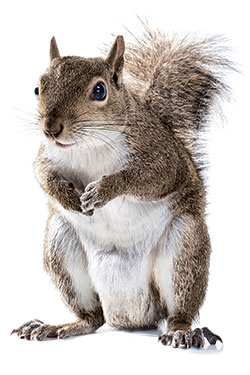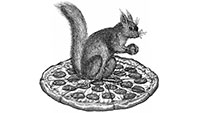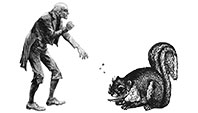
The American naturalist John Burroughs described the urban squirrel as an “elegant creature, so cleanly in its habits, so graceful in its carriage.” Today, like pigeons, the millions of gray squirrels that call New York City home occupy a weird and not particularly elegant place in our consciousness—most of us ignore them, and the ones who don’t are weirdos. And for that matter, New York isn’t exactly “home” for the critters. While most people tend to think of the neurotic gray squirrel as the archetypal local fauna, in fact the rodent had been almost completely eliminated in the city before being artificially reintroduced to Central Park to entertain Victorian passersby.
A Long-Tail Timeline:
Colonial Era
The gray squirrel is abundant in New York’s forests, living off the nuts of the now-rare American chestnut and providing meat for sharpshooters. The occasional tame squirrel is kept as a pet; Ben Franklin actually brought one named Mungo to England; when a dog dispatched the bushy émigré, Franklin wrote a eulogy.
Early 1800s
Rapid deforestation and urbanization causes squirrel flight—which should have spelled the end of squirrels in the city.
1856
The rodents are now such a novelty that when a pet squirrel escapes, the New-York Daily Times reports that the appearance of an “unusual visitor” in a downtown tree attracted hundreds of cheering rubberneckers, who had to be dispersed by cops.
1877
Spurred on by Victorian notions of man living in harmony with nature, the Central Park Menagerie releases a few gray squirrels into the Ramble; the next year, it adds an additional 30 pairs. In the previous decades, Boston, Philadelphia, and New Haven had tried to introduce small numbers of squirrels to public greens as entertainments for parkgoers but totally screwed it up, providing no food or habitat. (The ones that didn’t die off eventually were exterminated.) This time, in addition to plenty of nuts and trees, the city provides winter nesting boxes for squirrels and bags of peanuts for visitors to feed them. The result is a squirrel boom.
1883
There are now at least 1,500 in Central Park, and they’re destroying trees to make their nests. Despite ASPCA opposition, the city organizes a series of early-morning squirrel hunts for population control. (Pennsylvania had gone further, placing a bounty on the heads of squirrels.) The Central Park Menagerie’s director reports that one such hunt resulted in the felling of “fully a hundred fine fat squirrels.”

Late 1890s
Even as the city starts implementing squirrel-control measures, the animals attract a devoted following. New York papers report that various elderly eccentrics—including “a member of a noted dry-goods firm” and “a “tall, gray-haired man of military bearing”—are into feeding them. Around the same time, workers at Central Park and the Bronx Zoo accuse Italian laborers of hunting squirrels for food, and a guard in a Bronx park is beaten unconscious while trying to arrest a squirrel poacher.

1908
Marian Longfellow publishes “The Pensioner in Gray,” a sentimental poem that not so subtly equates the squirrel with the dependent elderly. The feeding and care of municipal squirrels had, by this point, become a social issue, an analog for responsibility to the poor. (A Thanksgiving Boston Globe headline ran, “Beggars, Squirrels, Birds—All Remembered”). Or for our lack of responsibility toward them: Echoing social arguments of the day, others felt the squirrels had become “lazy” and “pauperized” by their unnatural dependence on humans. No less a personage than Theodore Roosevelt accused pro-squirrel naturalists of sentimentalizing and idealizing wild animals for their own purposes.
1920s–1930s
The nascent ecological movement places more importance on the realities—rather than the idealization—of nature. Birds of prey and other natural squirrel predators are now regarded more highly, and the squirrel continues its fall from favor.
1968
The Great Squirrel Migration takes place across the East Coast, when an especially abundant 1967 acorn harvest drives squirrels to hunt out more places to store their food. Squirrels are witnessed swimming across the Connecticut River and other bodies of water. There are tons of roadkill casualties, and 100,000 drowned squirrels are pulled from a single New York reservoir.
1980s
Spurred by the green movement, parks start posting “No feeding” signs to cut down on human-squirrel relations. Hawks and falcons are now viewed as welcome guests.
1987
An adventurous (and possibly mischievous) squirrel steps onto a power line and shuts down nasdaq for 82 minutes, likely preventing more than 20 million shares from being traded and possibly sparking a revival of squirrel sympathy.
1994
A (presumably) different squirrel cripples nasdaq again. “We know it was a squirrel contact—they may have found the body,” says a spokeswoman for United Illuminating, which provides power to the exchange.
2001
The year of the cinnamon-squirrel boom. Reddish squirrels—actually a variant on eastern grays—proliferate, particularly in the Bronx. The New York Times reports, “For Squirrels, Cinnamon Is Now the New Black.”
2003
A mysterious squirrel is reportedly the first tenant at the under-construction Bloomberg Tower. Even construction workers are charmed by the squatter; the squirrel has become a friend again.
2010
Pearl the Squirrel, a perky squirrel park ranger who enjoys the color green, Shake Shack, and long bicycle rides, becomes the Parks Department’s new mascot.

2010
An 81-year-old Army vet is sentenced to 30 days for shooting a squirrel in his East Northport, Long Island, yard.
2011
What is described as a “tiny, adorable pet squirrel” attends the Zuccotti Park protests atop the shoulder of a Wall Street occupier.
2013
The reality era: An official squirrel-nest webcam goes live.